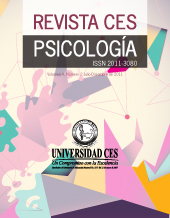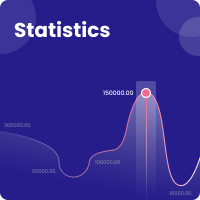Placebo Effect and Binaural Sound Stimulation of Beta Wave and Theta Wave in a Working Memory Task Performance
DOI:
https://doi.org/10.21615/cesp.13.1.3Keywords:
Working Memory, Binaural Sounds, AOSPAN, Computerized Assessment, Psychopy, Information Processing, Immediate Memory, Psychology, Experimental Psychology, Sound Stimulation, Short-Term Memory, Interference TestsAbstract
In this work, a quasi-experimental study of repeated measures with case and control groups was carried out, whose objective was to measure the effect of binaural sounds of beta and theta waves, and the placebo information related to them, on the performance of a computerized working memory task, Automated Operation Span Task -AOSPAN- free version of Unsworth, Heitz, Schrock and Engle (2005). This task was repeated in two sessions separated by an interval of two weeks, one of which was resolved while listening to a binaural sound stimulation of beta wave or theta that, depending on the group, was supported or not by placebo information. 98 people with different levels of schooling were tested twice, divided into six experimental groups and one control group. Significant differences were found related to time duration in performing the experimental task associated with placebo information; it was showed an improvement the second time the task was administered. Due to ambiguities in the results, despite finding significant differences associated with binaural stimulation of beta wave, it was not possible to establish concrete relations between the improvement in the memory of sets up four elements with the presence of this variable. No significant differences were found in the global recall variables, which can be explained by the type of memory task performed.
Downloads
References
Aguilar, M. (2004). Memoria. En Mestre, J. M., y Palmero F. (Eds.). Procesos Psicológicos Básicos: Una guía académica para los estudios en psicopedagogía, psicología y pedagogía (pp. 103-136). Madrid: McGraw-Hill.
Anderson, J. R., Qin, Y., Sohn, M. H., Stenger, V. A., & Carter, C. S. (2003). An information-processing model of the BOLD response in symbol manipulation tasks. Psychonomic Bulletin and Review, 10(2), 241–261. doi: https://doi.org/10.3758/BF03196490
Atkinson, R., & Shiffrin, R. (1971). The control of short-term memory. Scientific American, 225(2), 82-90.
Baddeley, A., & Hitch, G. (1974). Working memory. The psychology of learning and motivation, 8, 47-89.
Bakker-Marshall, I., Takashima, A., Schoffelen, J.-M., van Hell, J. G., Janzen, G., & McQueen, J. M. (2018). Theta-band Oscillations in the Middle Temporal Gyrus Reflect Novel Word Consolidation. Journal of Cognitive Neuroscience, 30(5), 621–633. doi: https://doi.org/10.1162/jocn_a_01240
Balderas, I. Ramírez, V., & Bermúdez, F. (2004). Cambios morfológicos asociados a la memoria. Revista de Neurología, 38(10), 944-948. Recuperado de: https://www.researchgate.net/profile/Federico_Bermudez-Rattoni/publication/8530785_Memory-linked_morphological_changes/links/551d995f0cf2a2d9e13afe4a.pdf
Beauchene, C., Abaid, N., Moran, R., Diana, R., & Leonessa, A. (2016). The Efect of Binaural Beats on Visuospatial Working Memory and Cortical Connectivity. Plos One, 11(11), 1-20. doi: https://doi.org/10.1371%2Fjournal.pone.0166630
Beauchene, C., Abaid, N., Moran, R., Diana, R. A., & Leonessa, A. (2017). The effect of binaural beats on verbal working memory and cortical connectivity. Journal of Neural Engineering, 14(2). doi: https://doi.org/10.1088/1741-2552/aa5d67
Becher, A. Höhne, M. Axmacher, N. Chaieb, L. Elger, C., & Fell, J. (2014). Intracranial electroencephalography power and phase synchronization changes during monaural and binaural beat stimulation. European Journal of Neuroscience, 41(2), 254-263. doi: https://doi.org/10.1111/ejn.12760
Benedetti, F., Mayberg, H. S., Wager, T. D., Stohler, C. S., & Zubieta, J.-K. (2005). Neurobiological Mechanisms of the Placebo Effect. Journal of Neuroscience, 25(45), 10390–10402. doi: https://doi.org/10.1523/JNEUROSCI.3458-05.2005
Boot, W. R., Simons, D. J., Stothart, C., & Stutts, C. (2013). The Pervasive Problem with Placebos in Psychology: Why Active Control Groups Are Not Sufficient to Rule Out Placebo Effects. Perspectives on Psychological Science, 8(4), 445–454. doi: https://doi.org/10.1177/1745691613491271
Carasatorre, M. Ramírez, V., & Díaz, S. (2016). Plasticidad sináptica estructural en el hipocampo inducida por la experiencia espacial y sus implicaciones en el procesamiento de información. Neurología, 31(8), 543-549. doi: https://doi.org/10.1016/j.nrl.2012.12.005
Carruthers, P (2013). La Evolución de la Memoria de Trabajo. Ludus Vitalis, 21(40), 99-124. Recuperado de: http://www.ludus-vitalis.org/ojs/index.php/ludus/article/view/41/41
Castillo, G. García, E., & Castillo, S. (2014). Sincronización cerebral con estimulación transcraneal. Acta Neurológica Colombiana, 30(2), 103-107. Recuperado de: http://www.acnweb.org/images/stories/pdf/acta2014/acta-2014_30_103-107.pdf
Chaieb, L., Höhne, M., Staresina, B., Elger, C. E., Hampel, K., Surges, R., & Fell, J. (2017). Modulation of long-term memory using auditory beat stimulation. Brain Stimulation, 10(2), 360. doi: https://doi.org/10.1016/j.brs.2017.01.061
Clemenson, G. D., Gage, F. H., & Stark, C. E. L. (2018). Environmental Enrichment and Neuronal Plasticity. In M. V. Chao (Ed.), The Oxford Handbook of Developmental Neural Plasticity (Vol. 85, pp. 283–284). Oxford University Press. doi: https://doi.org/10.1093/oxfordhb/9780190635374.013.13
Córdoba, A., Albert, J., & López, S. (2010). Potenciación a largo plazo en la corteza humana. Revista de Neurología, 51(6), 367-374. Recuperado de doi: http://www.neurologia.com/articulo/2009616
D’Esposito, M., & Postle, B. R. (2015). The Cognitive Neuroscience of Working Memory. Annual Review of Psychology, 66(1), 115–142. doi: https://doi.org/10.1146/annurev-psych-010814-015031
de la Fuente-Fernandez, R., Ruth, T. J., Sossi, V., Schulzer, M., Calne, D. B., & Stoessl, A. J. (2001). Expectation and Dopamine Release: Mechanism of the Placebo Effect in Parkinson’ s Disease. Science, 293(5532), 1164–1166.
Dodla, R., & Wilson, C. J. (2017). Effect of Phase Response Curve Shape and Synaptic Driving Force on Synchronization of Coupled Neuronal Oscillators. Neural Computation, 29(7), 1769–1814. doi: https://doi.org/10.1162/NECO_a_00978
Düzel, E., Penny, W. D., & Burgess, N. (2010). Brain oscillations and memory. Current Opinion in Neurobiology, 20(2), 245–257. doi: https://doi.org/10.1016/j.conb.2010.01.004
Engel, A. K., & Fries, P. (2010). Beta-band oscillations-signalling the status quo? Current Opinion in Neurobiology, 20(2), 156–165. doi: https://doi.org/10.1016/j.conb.2010.02.015
Etchepareborda, M., & Abad-Mas, L. (2005). Memoria de trabajo en los procesos básicos de aprendizaje. Revista de Neurología, 40(supl 1), S79-S83. Recuperado de: http://www.neurologia.com/articulo/2005078
Fajardo, A., & Guzman, A. (2016). Neurofeedback, aplicaciones y eficacia. Interdisciplinaria, 33(1), 81-93. Recuperado de: http://www.scielo.org.ar/pdf/interd/v33n1/v33n1a05.pdf
Figueiras, R., Magariños, C., Regidor, I., del Álamo,R., Cabañes, L., & Gómez, M. (2009). Estimulación cerebral profunda: 12 años de experiencia y 250 pacientes intervenidos con un seguimiento de más de un año. Revista de Neurología, 49(10), 511-516. Recuperado de: http://www.neurologia.com/articulo/2009055
Freigni, F., & Pascual-Leone, A. (2007). Technology Insight: noninvasive brain stimulation in neurology—perspectives on the therapeutic potential of rTMS and tDCS. Nature Reviews Neurology, 3(7), 383-393. doi: https://doi.org/10.1038/ncpneuro0530
Gao, X., Cao, H., Ming, D., Qi, H., Wang, X., Wang, X., & Peng, Z. (2014), Analysis of EEG Activity in Response to Binaural Beats with Different Frequencies. International Journal of Psychophysiology, 94(3), 399-406. doi: https://doi.org/10.1016/j.ijpsycho.2014.10.010
Garcia-Argibay, M., Santed, M. A., & Reales, J. M. (2017). Binaural auditory beats affect long-term memory. Psychological Research, 83(6) 1124–1136. doi: https://doi.org/10.1007/s00426-017-0959-2
Gonzales, P. (2013). Influencia de la estimulación sonora binaural en la generación de ondas cerebrales: Estudio electroencefalográfico. (Tesis Doctoral) Universidad Complutense de Madrid. Madrid, España. Recuperado de: http://eprints.ucm.es/21680/1/T34524.pdf
Goto, Y., Yang, C., & Otani, S. (2011). Plasticidad sináptica funcional y disfuncional en la corteza prefrontal: papel en los trastornos psiquiátricos. Psiquiatría Biológica, 18(1), 18-27. doi: https://doi.org/10.1016/j.psiq.2009.08.001
Gutiérrez, F., García, J., Carriedo, N., Vila, J., & Luzón, J. (2005). Dos pruebas de Amplitud de Memoria Operativa para el Razonamiento. Cognitiva, 17(2), 183-210. Recuperado de: http://portal.uned.es/pls/portal/docs/PAGE/UNED_MAIN/LAUNIVERSIDAD/UBICACIONES/02/DOCENTE/M._NURIA_CARRIEDO_LOPEZ/PUBLICACIONES/DOS%20PRUEBAS%20DE%20AMPLITUD%20DE%20MEMORIA%20OPERATIVA.PDF
Honey, G. D., Fu, C. H. Y., Kim, J., Brammer, M. J., Croudace, T. J., Suckling, J., … Bullmore, E. T. (2002). Effects of verbal working memory load on corticocortical connectivity modeled by path analysis of functional magnetic resonance imaging data. NeuroImage, 17(2), 573–582. doi: https://doi.org/10.1016/S1053-8119(02)91193-6
Ivanova, O. (2017). Fundamentos neurocognitivos del procesamiento lingüístico. Estudios de Lingüística Aplicada, 35(66), 235-261. doi: https://doi.org/10.22201/enallt.01852647p.2017.66.838
Kamigaki, T., & Dan, Y. (2017). Delay activity of specific prefrontal interneuron subtypes modulates memory-guided behavior. Nature Neuroscience, 20(6), 854–863. doi: https://doi.org/10.1038/nn.4554
Kennerly, R. C. (1994). An empirical investigation into the effect of beta frequency binaural beat audio signals on four measures of human memory (tesis de Maestría) West Georgia College. Georgia, EEUU. Recuperado de: http://www.nueva-mente.com/Research/13.htm
Khanna, P., & Carmena, J. M. (2015). Neural oscillations: Beta band activity across motor networks. Current Opinion in Neurobiology, 32, 60–67. doi: https://doi.org/10.1016/j.conb.2014.11.010
Leff, P., Retana, I. Arias, A., Zavala, E., Loria, F. Pavón, L., & Antón, B. (2004). Understanding the Neurobiological Mechanisms of Learning and Memory: Cellular, Molecular and Gene Regulation Implicated in Synaptic Plasticity and Long-Term Potentiation. Part IV A. Salud Mental, 27(2), 39-54. Recuperado de: http://new.medigraphic.com/cgi-bin/resumenI.cgi?IDARTICULO=16543
Llacanfil, N. (2013). Efectos de los infrasonidos en la conducta humana. (Tesis de pregrado) Universidad Austral de Chile. Valdivia, Chile. Recuperado de: http://cybertesis.uach.cl/tesis/uach/2013/bmfcil791e/doc/bmfcil791e.pdf
Morgado, I. (2005). Psicobiología del aprendizaje y la memoria: fundamentos y avances recientes. Revista de Neurología, 40(5), 289-297. Recuperado de: http://www.neurologia.com/articulo/2005004
Nicoll, R. A. (2017). A Brief History of Long-Term Potentiation. Neuron, 93(2), 281–290. doi: https://doi.org/10.1016/j.neuron.2016.12.015
Ortega Loubon, C., & Franco, J. (2010). Neurofisiología del aprendizaje y la memoria. Plasticidad Neuronal. Archivos de medicina, 6(1), 1-7. Recuperado de http://www.archivosdemedicina.com/medicina-de-familia/neurofisiologa-del-aprendizaje-y-la-memoria-plasticidad-neuronal.pdf
Peirce, J. W. (2007). PsychoPy - Psychophysics software in Python. Journal of Neuroscience Methods, 162(1-2), 8-13. doi: https://doi.org/10.1016/j.jneumeth.2006.11.017
Pluta, R. (2011). Deep Brain Stimulation. JAMA, 305(7), 732-732. Recuperado de: http://jamanetwork.com/journals/jama/fullarticle/645662?resultClick=1
Qin, Y., Carter, C. S., Silk, E. M., Stenger, V. A., Fissell, K., Goode, A., & Anderson, J. R. (2004). The change of the brain activation patterns as children learn algebra equation solving. Pnas, 101(15), 5686–5691. doi: https://doi.org/10.1073/pnas.0401227101
Radford, L., & André, M. (2009). Cerebro, Cognición y Matemáticas Brain. Revista Latinoamericana de Investigación En Matemática Educativa, 12, 215–250.
Scholz, S., Schneider, S. L., & Rose, M. (2017). Differential effects of ongoing EEG beta and theta power on memory formation. PLoS ONE, 12(2), 1–18. doi: https://doi.org/10.1371/journal.pone.0171913
Seifi Ala, T., Ahmadi-Pajouh, M. A., & Nasrabadi, A. M. (2018). Cumulative effects of theta binaural beats on brain power and functional connectivity. Biomedical Signal Processing and Control, 42, 242–252. doi: https://doi.org/10.1016/j.bspc.2018.01.022
Solís, H., & López-Hernández, E. (2009). Neuroanatomía funcional de la memoria. Archivos de Neurociencias (México), 14(3), 176–187.
Stelzer, F. Andés, M. Canet-Juric, L., & Introzzi, I. (2016). Memoria de Trabajo e Inteligencia Fluida. Una Revisión de sus Relaciones. Acta de Investigación Psicológica, 6(1), 2302-2316. doi: https://doi.org/10.1016/S2007-4719(16)30051-5
Turner, M., & Engle, R. (1989). Is Working Memory Capacity Task Dependent?. Journal of Memory and Language. 28, 127-154. doi: https://doi.org/10.1016/0749-596X(89)90040-5
Unsworth, N. Heitz, R. Schrock, J., & Engle, R. (2005). An automated version of the operation span task. Behavior Research Methods, 37(3), 498-505. Recuperado de: https://link.springer.com/article/10.3758/BF03192720
Vernon, D., Peryer, G., Louch, J., & Shaw, M. (2014). Tracking EEG changes in response to alpha and beta binaural beats. International Journal of Psychophysiology, 93(1), 134–139. doi: https://doi.org/10.1016/j.ijpsycho.2012.10.008
Wahbeh, H., Calabrese, C., Zwickey, H., & Zajdel, D. (2007). Binaural Beat Technology in Humans: A Pilot Study to Assess Neuropsychologic, Physiologic, and Electroencephalographic Effects. The Journal of Alternative and Complementary Medicine, 13(2), 109-206. doi: https://doi.org/10.1089/acm.2006.6201
Zatorre, R. J. (2015). Musical pleasure and reward: Mechanisms and dysfunction. Annals of the New York Academy of Sciences, 1337(1), 202–211. doi: https://doi.org/10.1111/nyas.12677
Downloads
Published
How to Cite
Issue
Section
License

This work is licensed under a Creative Commons Attribution-NonCommercial-ShareAlike 4.0 International License.
Each manuscript is accompanied by a statement specifyingThat the materials are unpublished, that have not been previously published in printed formatElectronic and that they will not be presented to any other means before knowing the decision of the magazine. ThroughoutIn case, any previous publication, sea in printed or electronic form, must be made known to the editorial staffWriting The authors attach a signed statement stating that, and the manuscript is acceptedFor publication, the rights of reproduction are the exclusive property of the Journal CES Psychology.| Article metrics | |
|---|---|
| Abstract views | |
| Galley vies | |
| PDF Views | |
| HTML views | |
| Other views | |




